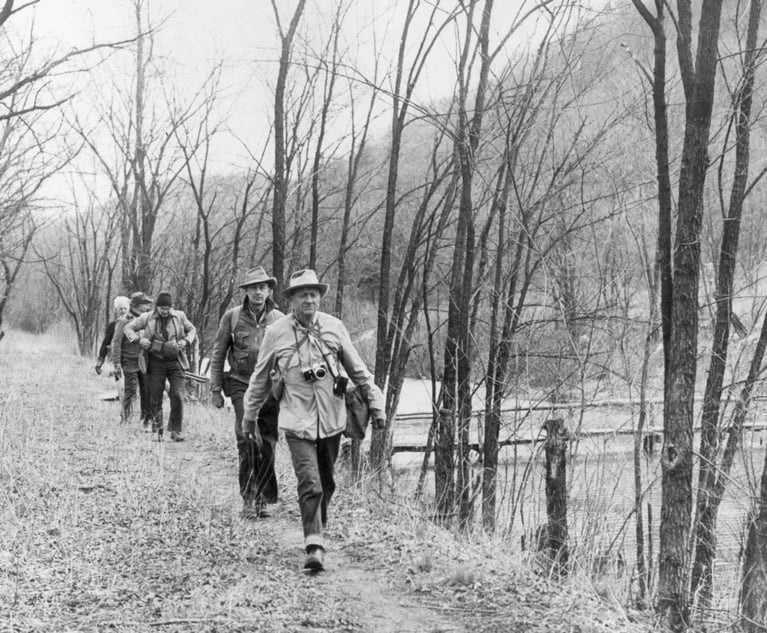 In 1954, Justice William O. Douglas led a hike along the Chesapeake & Ohio Canal in a campaign to keep the canal from being turned into a highway. Courtesy of the National Park Service
In 1954, Justice William O. Douglas led a hike along the Chesapeake & Ohio Canal in a campaign to keep the canal from being turned into a highway. Courtesy of the National Park Service The Marble Palace Blog: Justice William O. Douglas, an Early Activist of the Environmental Movement
A compelling new book by a Ninth Circuit judge focuses on the conservation advocacy of Douglas and his high public profile, unlike any other.
September 06, 2022 at 11:45 AM
6 minute read
Thank you for reading The Marble Palace Blog, which I hope will inform and surprise you about the Supreme Court of the United States. My name is Tony Mauro. I've covered the Supreme Court since 1979 and for ALM since 2000. I semiretired in 2019, but I am still fascinated by the high court. I'll welcome any tips or suggestions for topics to write about. You can reach me at [email protected].
M. Margaret McKeown, a judge on the U.S. Court of Appeals for the Ninth Circuit, was born in Casper, Wyoming, and calls herself a "child of the American West" who has a passion for the outdoors.
When she came East for law school at Georgetown University Law Center in 1975, she spent a lot of time at the C&O Canal near the Potomac River, which the late Justice William O. Douglas prevented from being turned into a highway. She became a Ninth Circuit judge in 1998.
Fast-forward: McKeown recently decided to write about Douglas and his passion for the outdoors, and how he became an environmental crusader while also working as a Supreme Court justice for 36 years, the longest tenure of any associate justice in history.
McKeown wrote an article in 2019 in the Journal of Supreme Court History about Douglas and his dissent in the 1972 Sierra Club v. Morton case, in which he famously asserted that environmental entities such as rivers or valleys could have standing to "sue for their own preservation." McKeown decided to broaden the story of his environmental legacy. "It was a lark that turned into a book," McKeown said in an interview with the National Law Journal's Christine Schiffner.
It is a compelling and very readable book. Though the focus was on the environment, McKeown dealt with the fact that Douglas is best known as the "justice with four wives." She wrote, "That Diego Rivera had four wives hardly meant that he was not a great painter. So while the 'four wives' soundbite may be a legitimate moral judgment, it should not define Douglas."
The book is titled "CITIZEN JUSTICE: The Environmental Legacy of William O. Douglas—Public Advocate and Conservation Champion" and is available on Amazon.
In this Q&A I asked McKeown, among other things, whether Douglas' unabashed advocacy in favor of conservation and the environment ruffled feathers among his colleagues:
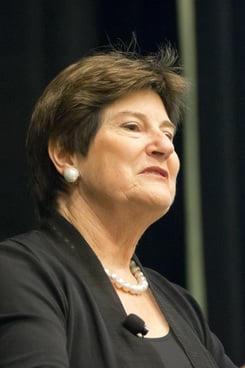 Judge M. Margaret McKeown of the U.S. Court of Appeals for the Ninth Circuit. Credit: Jason Doiy/ALM
Judge M. Margaret McKeown of the U.S. Court of Appeals for the Ninth Circuit. Credit: Jason Doiy/ALM There have been many biographies of William O. Douglas. Why did you decide to write this one, focused on environmental issues?
It is true there are several biographies and I started out on a research lark, not intending to write a book. I began with the curious question of how Justice Douglas intersected with Olaus Murie from Wyoming (my home state), who was a famous conservationist and president of the Wilderness Society. But my research led me to the broader environmental theme and how remarkable it was that Douglas literally ran a one-man lobby shop from the Supreme Court. I decided the story was too interesting and important to be left untold.
How did you research Douglas' papers, and did the pandemic make it difficult?
I spent many happy hours at the Library of Congress, the archive for Douglas' many boxes of personal and court papers. He was an amazing pack rat. Fortunately, by the time of the pandemic, I had finished most of my research. Otherwise, the project would have come to a standstill. Mostly, I used the pandemic as an opportunity to actually write the book.
What was the trigger that shifted Douglas from politics to the environment?
During his first decade on the court, Douglas was focused on politics. In 1949 he had a near-fatal horse accident. By the early 1950s, as his marriage was on the rocks, he was a bit bored with the court, and his political star had faded. In 1954, the Washington Post ran an editorial supporting a National Park Service plan to put a highway into the C&O Canal. Douglas quickly wrote a letter protesting the plan and invited the editors to come hike with him on the canal. What followed was Douglas' famous 189-mile protest hike on the canal. The Post editors changed their minds. Ultimately, the highway was never built. I benchmark this protest as sparking Douglas' passion for public protests and the beginning of his three decades of environmental activism and serving as a band leader for the conservation/environmental movement.
Is there anything like Douglas' C&O Canal hike that comes close to another justice in terms of high-profile public advocacy?
Nothing comes close to Douglas' C&O hike (and follow-on hikes) in terms of public advocacy. But Justice Felix Frankfurter was an "all-purpose" adviser to Roosevelt. Justices Louis Brandeis and Frankfurter were also publicly prominent in the Zionist cause. Other justices were mostly behind-the-scenes advisers but played prominent roles with presidents over time.
Did other justices frown on Douglas' highly public activities?
Because Douglas had a brilliant mind and wrote quickly, he was never behind in his work and no one suggested he was shirking his duties, although the justices were more than miffed when he flew West in late June even before all of the other opinions were in. However, when he sat on the Sierra Club v. Morton case, there was scuttlebutt around the court and among the justices as to whether he should sit on the case because of his close relationship with the Sierra Club. He had been on the board of the Sierra Club earlier and he resigned his life membership with the Sierra Club while the case was pending in the court. Douglas was in a league of his own. He was a canary in the coal mine in terms of railing about pollution, pesticides, dams, and loss of wilderness, and he even wrote a book called "The Wilderness Bill of Rights."
NOT FOR REPRINT
© 2025 ALM Global, LLC, All Rights Reserved. Request academic re-use from www.copyright.com. All other uses, submit a request to [email protected]. For more information visit Asset & Logo Licensing.
You Might Like
View All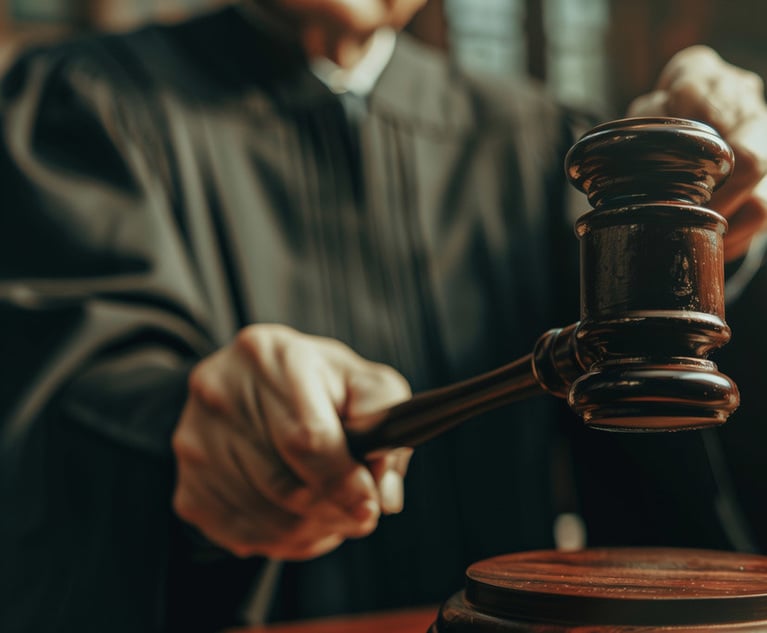
Who Are the Judges Assigned to Challenges to Trump’s Birthright Citizenship Order?

‘Undermines the Rule of Law’: Retired US Judges Condemn Trump’s Jan. 6 Pardons
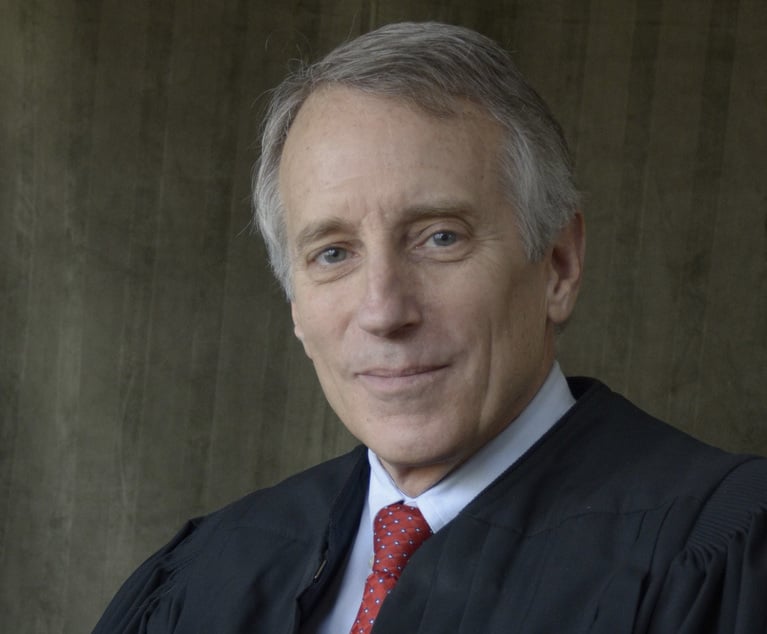
'If the Job Is Better, You Get Better': Chief District Judge Discusses Overcoming Negative Perceptions
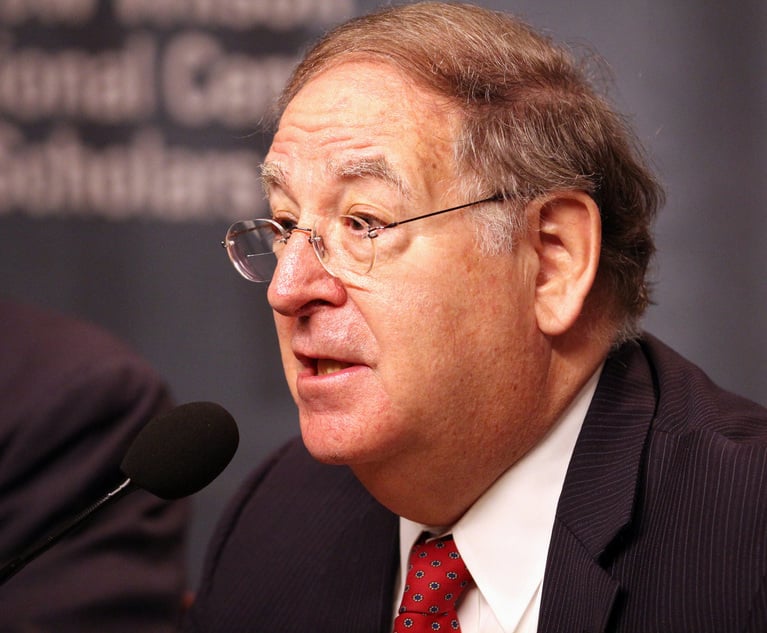
'Thoughtful Jurist': Maryland US District Senior Judge Messitte Dies After Short Illness
4 minute readTrending Stories
- 1Uber Files RICO Suit Against Plaintiff-Side Firms Alleging Fraudulent Injury Claims
- 2The Law Firm Disrupted: Scrutinizing the Elephant More Than the Mouse
- 3Inherent Diminished Value Damages Unavailable to 3rd-Party Claimants, Court Says
- 4Pa. Defense Firm Sued by Client Over Ex-Eagles Player's $43.5M Med Mal Win
- 5Losses Mount at Morris Manning, but Departing Ex-Chair Stays Bullish About His Old Firm's Future
Who Got The Work
J. Brugh Lower of Gibbons has entered an appearance for industrial equipment supplier Devco Corporation in a pending trademark infringement lawsuit. The suit, accusing the defendant of selling knock-off Graco products, was filed Dec. 18 in New Jersey District Court by Rivkin Radler on behalf of Graco Inc. and Graco Minnesota. The case, assigned to U.S. District Judge Zahid N. Quraishi, is 3:24-cv-11294, Graco Inc. et al v. Devco Corporation.
Who Got The Work
Rebecca Maller-Stein and Kent A. Yalowitz of Arnold & Porter Kaye Scholer have entered their appearances for Hanaco Venture Capital and its executives, Lior Prosor and David Frankel, in a pending securities lawsuit. The action, filed on Dec. 24 in New York Southern District Court by Zell, Aron & Co. on behalf of Goldeneye Advisors, accuses the defendants of negligently and fraudulently managing the plaintiff's $1 million investment. The case, assigned to U.S. District Judge Vernon S. Broderick, is 1:24-cv-09918, Goldeneye Advisors, LLC v. Hanaco Venture Capital, Ltd. et al.
Who Got The Work
Attorneys from A&O Shearman has stepped in as defense counsel for Toronto-Dominion Bank and other defendants in a pending securities class action. The suit, filed Dec. 11 in New York Southern District Court by Bleichmar Fonti & Auld, accuses the defendants of concealing the bank's 'pervasive' deficiencies in regards to its compliance with the Bank Secrecy Act and the quality of its anti-money laundering controls. The case, assigned to U.S. District Judge Arun Subramanian, is 1:24-cv-09445, Gonzalez v. The Toronto-Dominion Bank et al.
Who Got The Work
Crown Castle International, a Pennsylvania company providing shared communications infrastructure, has turned to Luke D. Wolf of Gordon Rees Scully Mansukhani to fend off a pending breach-of-contract lawsuit. The court action, filed Nov. 25 in Michigan Eastern District Court by Hooper Hathaway PC on behalf of The Town Residences LLC, accuses Crown Castle of failing to transfer approximately $30,000 in utility payments from T-Mobile in breach of a roof-top lease and assignment agreement. The case, assigned to U.S. District Judge Susan K. Declercq, is 2:24-cv-13131, The Town Residences LLC v. T-Mobile US, Inc. et al.
Who Got The Work
Wilfred P. Coronato and Daniel M. Schwartz of McCarter & English have stepped in as defense counsel to Electrolux Home Products Inc. in a pending product liability lawsuit. The court action, filed Nov. 26 in New York Eastern District Court by Poulos Lopiccolo PC and Nagel Rice LLP on behalf of David Stern, alleges that the defendant's refrigerators’ drawers and shelving repeatedly break and fall apart within months after purchase. The case, assigned to U.S. District Judge Joan M. Azrack, is 2:24-cv-08204, Stern v. Electrolux Home Products, Inc.
Featured Firms
Law Offices of Gary Martin Hays & Associates, P.C.
(470) 294-1674
Law Offices of Mark E. Salomone
(857) 444-6468
Smith & Hassler
(713) 739-1250








